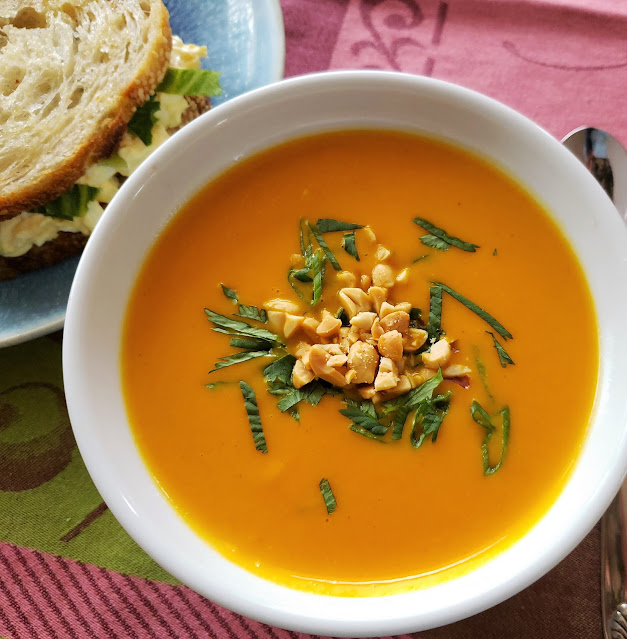As is my habit during the early days
of the new year, I have been making and enjoying lots of soup. It really is the perfect food for
January. Not only is it soothing and
warm on a dark, cold…and more often than not, wet…day—it is just the thing
after the dietary excesses of the holidays.
Not surprisingly, this is also the
time of year when I have traditionally taught soup classes. Most of the recipes that were part of my
class rotation have already appeared on my blog. The carrot and ginger soup I’m posting today
was always a class favorite. I’m not
sure why I never posted the recipe here.
It might be because the presence of fresh ginger…and lime…and
cilantro…put it just outside the reaches of my normal home pantry. But I have had fresh ginger on hand quite a
bit in recent weeks for various things I’ve been working on…and since I always
have carrots (and I’ve been in the mood for soup)…the other day I thought of
this soup. I was so glad I did. The warm color—and tummy soothing ginger—make
it a great post holiday/mid-winter soup.
I’m sure that in previous posts for
puréed
soups I have had a lot to say about the process. But since it’s been a while since I wrote one
of those posts, I’ll just repeat a few essentials here:
First…make sure you aren’t
shortcutting the initial cooking of the onions and carrots in the fat. This process allows the flavors of these
vegetables to infuse the fats and give a deeper flavor to the final soup. And along those lines, make sure your
vegetables are fully cooked before you purée the soup, or you’ll have a coarse purée. (The cooked
vegetables should be tender to the tip of a knife—and you should be able to
mash them against a plate with a fork or spoon).
Also, when adding liquid to a soup
that is to be puréed, always hold back some—adding just what is necessary to cover the
vegetables well and cook them through.
If too much liquid is added at this early stage, the final soup might be
way too thin (and I say this as someone who prefers thinner soups). You can always (and likely will) add more
liquid while you are puréeing the
soup. I like the final consistency of my
puréed soups to be like thick cream—it
shouldn’t mound in the bowl or on the spoon (and should be “sippable”).
If you are using a traditional
blender, don’t fill it too full with the hot soup (2/3 full is about right). The pressure build up when you turn on the
blender will push the cap up and off and if the blender is too full you’ll have a mess—and possibly a
burn.
Finally, I always pass my puréed soups through a
fine meshed sieve. I think it gives the
most suave and velvety texture. But I
understand that some find this step to be a bit persnickety…and it also adds to
the washing up. Be assured that the soup
will taste just as good without straining out the lingering fibrous bits. Whether you are straining the soup or not
though, take the time to run the blender until the soup is super smooth
(you’ll be glad you did!).
If you make this soup, be aware that
its flavors are an interplay of strong and subtle…and that they change a bit
over time. On the day it is made, the
ginger flavor is strong…and the soup has a warm spiciness. The next day, the ginger flavor will be much
more subtle. If you like a stronger ginger flavor, simply
add a grating of fresh ginger when you are reheating the soup on subsequent
days. If you want to eat it the day you
make it…and you don’t like the strong flavor of the ginger, just add the ginger
with the stock—its flavor will soften under the longer cooking time. As far as the lime goes, it is added to
balance not only the sweetness of the carrots, but also the honey. It should not really be seen as the
addition of lime flavor (although it will add a little)—but rather as a way to
lift and brighten the flavors of the whole soup. If you want a stronger lime flavor, add a
grating of zest to the final soup (or as a garnish).
As I type this post today, I have a
lovely view of snow covered trees. For
the most part, people in my area are staying in after last night’s snowfall if they
can. It is just the right kind of day
for this soup. And even if you don’t
typically keep fresh ginger in your home pantry, you can still make a carrot
soup (without a run to the store) because this soup also happens to be a great
template for a basic carrot soup. Simply
omit the honey, lime & ginger and you will have a delicious soup, the
makings of which will already be in most home pantries.
Gingered Carrot Soup
2 T. olive oil
1 large onion
(8 to 9 oz.), thinly sliced
1 T. unsalted butter
1 lb. carrots,
peeled and thinly sliced
1 T. rice
(Basmati, Jasmine, Arborio, etc.)
1/2 t. ground coriander
1 t. paprika
1 t. cumin
1 T. honey
3 to 4 c. chicken
or vegetable stock
2 T. (18 g.)
minced fresh ginger (or more to taste)
1/4 c. heavy
cream
1 T. freshly
squeezed lime juice (or to taste)
Salt &
PepperPossible
garnishes (alone, or in a combination that pleases you): Fresh Cilantro
chiffonade, thinly sliced green onion tops, chopped peanuts, toasted pepitas, lime
zest, olive oil, crispy fried shallots
In a medium
stockpot or large saucepan, heat the olive oil over medium heat. Add the onion along with a generous pinch of
salt and sweat, covered, until the onions are soft and translucent—about 10 to
15 minutes.
Add the carrots another good pinch
of salt and cook for 5 to 10 minutes—until carrots are beginning to
soften.
Add the spices and the rice and
cook another 2 to 3 minutes to toast the spices and rice. Add the honey, stirring and cooking until the
vegetables are coated and everything is sizzling nicely. Add 3 cups of stock (or whatever you need to
cover all the vegetables so that they are moving freely—reserve the remaining
stock to add as needed when pureeing the soup). Bring the soup to a simmer, cover and cook until the carrots are very
soft—about 20 to 25 minutes, adding the ginger during the last 5 minutes of
cooking.
Purée the soup (using a
traditional blender or an immersion blender), adding more stock as is necessary
to produce a smooth, thin purée. Pass through
a fine meshed strainer if you like to achieve an even more suave and velvety
texture.
Return the
soup to the pot and add the cream. Heat
through. Remove from the heat and add
the lime juice to taste. You may also
add more freshly grated ginger if you like.
Correct the seasoning and serve immediately, garnished as you please. Makes a scant 6 cups.









.jpg)
.jpg)
.jpg)

.jpg)
.jpg)





